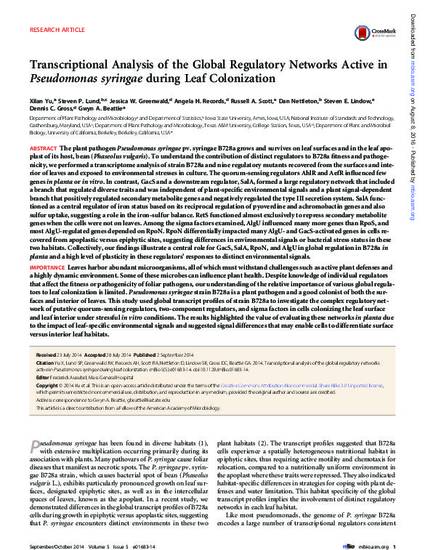
The plant pathogen Pseudomonas syringae pv. syringae B728a grows and survives on leaf surfaces and in the leaf apoplast of its host, bean (Phaseolus vulgaris). To understand the contribution of distinct regulators to B728a fitness and pathogenicity, we performed a transcriptome analysis of strain B728a and nine regulatory mutants recovered from the surfaces and interior of leaves and exposed to environmental stresses in culture. The quorum-sensing regulators AhlR and AefR influenced few genes in planta or in vitro. In contrast, GacS and a downstream regulator, SalA, formed a large regulatory network that included a branch that regulated diverse traits and was independent of plant-specific environmental signals and a plant signal-dependent branch that positively regulated secondary metabolite genes and negatively regulated the type III secretion system. SalA functioned as a central regulator of iron status based on its reciprocal regulation of pyoverdine and achromobactin genes and also sulfur uptake, suggesting a role in the iron-sulfur balance. RetS functioned almost exclusively to repress secondary metabolite genes when the cells were not on leaves. Among the sigma factors examined, AlgU influenced many more genes than RpoS, and most AlgU-regulated genes depended on RpoN. RpoN differentially impacted many AlgU- and GacS-activated genes in cells recovered from apoplastic versus epiphytic sites, suggesting differences in environmental signals or bacterial stress status in these two habitats. Collectively, our findings illustrate a central role for GacS, SalA, RpoN, and AlgU in global regulation in B728a in planta and a high level of plasticity in these regulators’ responses to distinct environmental signals.
Available at: http://works.bepress.com/gwyn-beattie/15/

This article is from mBio 5 (2014): e01683-14, doi: 10.1128/mBio.01683-14.